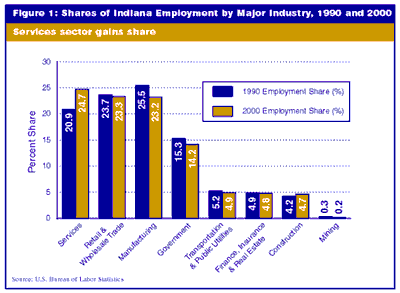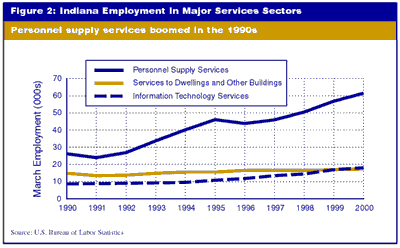Business Services Sector Increases Its Share of Jobs
Within the services sector of the Indiana economy over the last decade, one of the most robust segments was the heterogeneous group of enterprises included under the heading of business services.
During a period when most industry divisions held or lost ground in terms of their share of Indiana's employment, the services sector enlarged its share of Indiana's employment pie by 3.8 percentage points (see Figure 1). Within the sector, business services employment grew even faster, from 16.3% of total services (84,700 out of 519,700) in 1990 to 20.5% in 2000 (150,200 out of 733,700).

The burgeoning business services sector is made up of eight categories: advertising; consumer credit reporting agencies, mercantile reporting agencies, and adjustment and collection agencies; mailing, reproduction, commercial art and photography, and stenographic services; services to dwellings and other buildings; miscellaneous equipment rental and leasing; personnel supply services; computer programming, data processing and other computer-related services; and miscellaneous business services. Examples of types of establishments that fall under each category are listed below.
- Advertising: Traditional advertising agencies, billboard advertising, handbill-distribution services, shopping news advertising and skywriting.
- Consumer Credit Reporting Agencies, Mercantile Reporting Agencies, and Adjustment and Collection Agencies: Consumer credit-reporting bureaus, credit-investigation services and collection agencies.
- Mailing, Reproduction, Commercial Art and Photography, and Stenographic Services: Direct-mail advertising services, photocopying and duplicating services, commercial photography, commercial art and graphic design, and secretarial and court reporting services (including résumé writing and word-processing services).
- Services to Dwellings and Other Buildings: Disinfecting and pest control, and building cleaning and maintenance services.
- Miscellaneous Equipment Rental and Leasing: Medical equipment rental and leasing, heavy construction equipment rental and leasing, and other miscellaneous equipment rental and leasing (from tools to video recorders, to pianos, to office machines, to airplanes, to party supplies).
- Personnel Supply Services: Employment agencies (from registries for nurses, maids, chauffeurs and ship crews to executive placement services and labor contractors) and help supply agencies, including temporary help services and employee leasing services.
- Computer Programming, Data Processing and Other Computer-Related Services: Programmer services and custom software development; design, development and production of pre-packaged software; integrated systems design; computer time share, optical scanning and data entry services; computer rental and leasing; maintenance and repair services; and computer consultants.
- Miscellaneous Business Services: Runs the gamut from armored car services, detective agencies, private investigators, security guard services and security systems for homes and businesses to news syndicates, photo-finishing laboratories, swimming pool cleaning, automobile repossession, arbitration, check validation, interior decoration, speakers bureaus, telemarketing and even time-of-day services.
Three Largest Services Sectors
The U.S. Bureau of Labor Statistics tracks statewide employment in the three largest segments of business services on a monthly basis. Its Current Employment Statistics survey covers services to dwellings and other buildings; personnel supply services; and computer programming, data processing and other computer-related services, commonly referred to as information technology services. Figure 2 shows the March employment level in these three segments from 1990 to 2000. The dip in 1991 reflects Indiana's most recent recession. The 1996 drop in personnel supply services resulted from weakness in this industry across the entire country in the last quarter of 1995, combined with a larger-than-usual December-to-January drop. Analysis at the time attributed this nationwide pattern to general sluggishness in the economy. Personnel supply services did show significant recovery during the remainder of 1996 and was almost back to the 1995 level by January 1997.

The information technology sector also showed rather remarkable growth, especially since 1995, as networks, e-mail, the Internet and "e-commerce" have become key components of survival for many businesses.
Another force fueling this growth in business services was the ongoing downsizing at companies in Indiana. Firms in many industry segments moved to contract out services and functions not perceived as "core" to their corporate mission, including such former in-house functions as personnel recruiting, software development and programming.
In addition, the use of temporary services and labor leasing ballooned as employers sought to trim benefit costs and sidestep the hassles of recruiting personnel in a tight labor market. Employment statistics for leased employees are not typically allocated to the industry in which they are working. Therefore, employment in the personnel supply services sector expanded while the industry sectors that actually were utilizing the workers appeared to shrink. At least in part, then, the job growth in business services has reflected the shifting of jobs from other industry sectors into the business services category, rather than outright job creation
Next Article: Local Unemployment Rates Spread over Wide Range